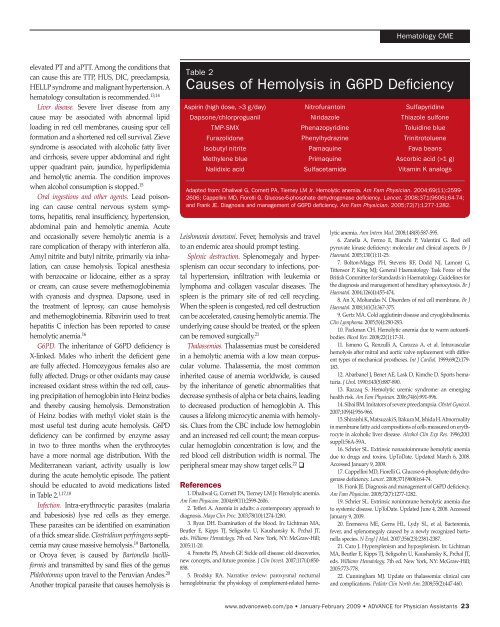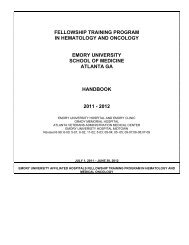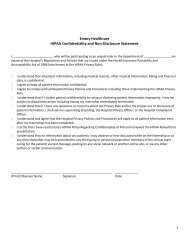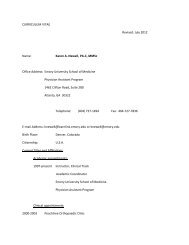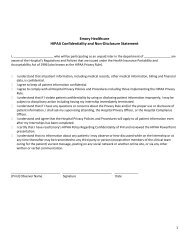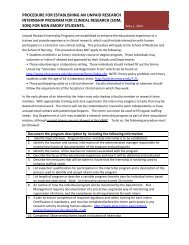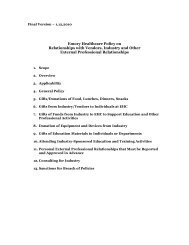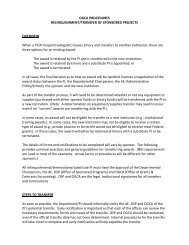Hemolysis - Emory University School of Medicine
Hemolysis - Emory University School of Medicine
Hemolysis - Emory University School of Medicine
Create successful ePaper yourself
Turn your PDF publications into a flip-book with our unique Google optimized e-Paper software.
Hematology CME<br />
elevated PT and aPTT. Among the conditions that<br />
can cause this are TTP, HUS, DIC, preeclampsia,<br />
HELLP syndrome and malignant hypertension. A<br />
hematology consultation is recommended. 13,14<br />
Liver disease. Severe liver disease from any<br />
cause may be associated with abnormal lipid<br />
loading in red cell membranes, causing spur cell<br />
formation and a shortened red cell survival. Zieve<br />
syndrome is associated with alcoholic fatty liver<br />
and cirrhosis, severe upper abdominal and right<br />
upper quadrant pain, jaundice, hyperlipidemia<br />
and hemolytic anemia. The condition improves<br />
when alcohol consumption is stopped. 15<br />
Oral ingestions and other agents. Lead poisoning<br />
can cause central nervous system symptoms,<br />
hepatitis, renal insufficiency, hypertension,<br />
abdominal pain and hemolytic anemia. Acute<br />
and occasionally severe hemolytic anemia is a<br />
rare complication <strong>of</strong> therapy with interferon alfa.<br />
Amyl nitrite and butyl nitrite, primarily via inhalation,<br />
can cause hemolysis. Topical anesthesia<br />
with benzocaine or lidocaine, either as a spray<br />
or cream, can cause severe methemoglobinemia<br />
with cyanosis and dyspnea. Dapsone, used in<br />
the treatment <strong>of</strong> leprosy, can cause hemolysis<br />
and methemoglobinemia. Ribavirin used to treat<br />
hepatitis C infection has been reported to cause<br />
hemolytic anemia. 16<br />
G6PD. The inheritance <strong>of</strong> G6PD deficiency is<br />
X‐linked. Males who inherit the deficient gene<br />
are fully affected. Homozygous females also are<br />
fully affected. Drugs or other oxidants may cause<br />
increased oxidant stress within the red cell, causing<br />
precipitation <strong>of</strong> hemoglobin into Heinz bodies<br />
and thereby causing hemolysis. Demonstration<br />
<strong>of</strong> Heinz bodies with methyl violet stain is the<br />
most useful test during acute hemolysis. G6PD<br />
deficiency can be confirmed by enzyme assay<br />
in two to three months when the erythrocytes<br />
have a more normal age distribution. With the<br />
Mediterranean variant, activity usually is low<br />
during the acute hemolytic episode. The patient<br />
should be educated to avoid medications listed<br />
in Table 2. 1,17,18<br />
Infection. Intra-erythrocytic parasites (malaria<br />
and babesiosis) lyse red cells as they emerge.<br />
These parasites can be identified on examination<br />
<strong>of</strong> a thick smear slide. Clostridium perfringens septicemia<br />
may cause massive hemolysis. 19 Bartonella,<br />
or Oroya fever, is caused by Bartonella bacilliformis<br />
and transmitted by sand flies <strong>of</strong> the genus<br />
Phlebotomus upon travel to the Peruvian Andes. 20<br />
Another tropical parasite that causes hemolysis is<br />
Table 2<br />
Causes <strong>of</strong> <strong>Hemolysis</strong> in G6PD Deficiency<br />
Aspirin (high dose, >3 g/day)<br />
Dapsone/chlorproguanil<br />
TMP-SMX<br />
Furazolidone<br />
Isobutyl nitrite<br />
Methylene blue<br />
Nalidixic acid<br />
Adapted from: Dhaliwal G, Cornett PA, Tierney LM Jr. Hemolytic anemia. Am Fam Physician. 2004;69(11):2599-<br />
2606; Cappellini MD, Fiorelli G. Glucose-6-phosphate dehydrogenase deficiency. Lancet. 2008;371(9606):64-74;<br />
and Frank JE. Diagnosis and management <strong>of</strong> G6PD deficiency. Am Fam Physician. 2005;72(7):1277-1282.<br />
Leishmania donovani. Fever, hemolysis and travel<br />
to an endemic area should prompt testing.<br />
Splenic destruction. Splenomegaly and hypersplenism<br />
can occur secondary to infections, portal<br />
hypertension, infiltration with leukemia or<br />
lymphoma and collagen vascular diseases. The<br />
spleen is the primary site <strong>of</strong> red cell recycling.<br />
When the spleen is congested, red cell destruction<br />
can be accelerated, causing hemolytic anemia. The<br />
underlying cause should be treated, or the spleen<br />
can be removed surgically. 21<br />
Thalassemias. Thalassemias must be considered<br />
in a hemolytic anemia with a low mean corpuscular<br />
volume. Thalassemia, the most common<br />
inherited cause <strong>of</strong> anemia worldwide, is caused<br />
by the inheritance <strong>of</strong> genetic abnormalities that<br />
decrease synthesis <strong>of</strong> alpha or beta chains, leading<br />
to decreased production <strong>of</strong> hemoglobin A. This<br />
causes a lifelong microcytic anemia with hemolysis.<br />
Clues from the CBC include low hemoglobin<br />
and an increased red cell count; the mean corpuscular<br />
hemoglobin concentration is low, and the<br />
red blood cell distribution width is normal. The<br />
peripheral smear may show target cells. 22 <br />
Nitr<strong>of</strong>urantoin<br />
Niridazole<br />
Phenazopyridine<br />
Phenylhydrazine<br />
Pamaquine<br />
Primaquine<br />
Sulfacetamide<br />
Sulfapyridine<br />
Thiazole sulfone<br />
Toluidine blue<br />
Trinitrotoluene<br />
Fava beans<br />
Ascorbic acid (>1 g)<br />
Vitamin K analogs<br />
References<br />
1. Dhaliwal G, Cornett PA, Tierney LM Jr. Hemolytic anemia.<br />
Am Fam Physician. 2004;69(11):2599-2606.<br />
2. Tefferi A. Anemia in adults: a contemporary approach to<br />
diagnosis. Mayo Clin Proc. 2003;78(10):1274-1280.<br />
3. Ryan DH. Examination <strong>of</strong> the blood. In: Lichtman MA,<br />
Beutler E, Kipps TJ, Seligsohn U, Kaushansky K, Prchal JT,<br />
eds. Williams Hematology. 7th ed. New York, NY: McGraw-Hill;<br />
2005:11-20.<br />
4. Frenette PS, Atweh GF. Sickle cell disease: old discoveries,<br />
new concepts, and future promise. J Clin Invest. 2007;117(4):850-<br />
858.<br />
5. Brodsky RA. Narrative review: paroxysmal nocturnal<br />
hemoglobinuria: the physiology <strong>of</strong> complement-related hemolytic<br />
anemia. Ann Intern Med. 2008;148(8):587-595.<br />
6. Zanella A, Fermo E, Bianchi P, Valentini G. Red cell<br />
pyruvate kinase deficiency: molecular and clinical aspects. Br J<br />
Haematol. 2005;130(1):11-25.<br />
7. Bolton-Maggs PH, Stevens RF, Dodd NJ, Lamont G,<br />
Tittensor P, King MJ; General Haematology Task Force <strong>of</strong> the<br />
British Committee for Standards in Haematology. Guidelines for<br />
the diagnosis and management <strong>of</strong> hereditary spherocytosis. Br J<br />
Haematol. 2004;126(4):455-474.<br />
8. An X, Mohandas N. Disorders <strong>of</strong> red cell membrane. Br J<br />
Haematol. 2008;141(3):367-375.<br />
9. Gertz MA. Cold agglutinin disease and cryoglobulinemia.<br />
Clin Lymphoma. 2005;5(4):290-293.<br />
10. Packman CH. Hemolytic anemia due to warm autoantibodies.<br />
Blood Rev. 2008;22(1):17-31.<br />
11. Ismeno G, Renzulli A, Carozza A, et al. Intravascular<br />
hemolysis after mitral and aortic valve replacement with different<br />
types <strong>of</strong> mechanical prostheses. Int J Cardiol. 1999;69(2):179-<br />
183.<br />
12. Abarbanel J, Benet AE, Lask D, Kimche D. Sports hematuria.<br />
J Urol. 1990;143(5):887-890.<br />
13. Razzaq S. Hemolytic uremic syndrome: an emerging<br />
health risk. Am Fam Physician. 2006;74(6):991-996.<br />
14. Sibai BM. Imitators <strong>of</strong> severe preeclampsia. Obstet Gynecol.<br />
2007;109(4):956-966.<br />
15. Shiraishi K, Matsuzaki S, Itakura M, Ishida H. Abnormality<br />
in membrane fatty acid compositions <strong>of</strong> cells measured on erythrocyte<br />
in alcoholic liver disease. Alcohol Clin Exp Res. 1996;20(1<br />
suppl):56A-59A.<br />
16. Schrier SL. Extrinsic nonautoimmune hemolytic anemia<br />
due to drugs and toxins. UpToDate. Updated March 6, 2008.<br />
Accessed January 9, 2009.<br />
17. Cappellini MD, Fiorelli G. Glucose-6-phosphate dehydrogenase<br />
deficiency. Lancet. 2008;371(9606):64-74.<br />
18. Frank JE. Diagnosis and management <strong>of</strong> G6PD deficiency.<br />
Am Fam Physician. 2005;72(7):1277-1282.<br />
19. Schrier SL. Extrinsic nonimmune hemolytic anemia due<br />
to systemic disease. UpToDate. Updated June 4, 2008. Accessed<br />
January 9, 2009.<br />
20. Eremeeva ME, Gerns HL, Lydy SL, et al. Bacteremia,<br />
fever, and splenomegaly caused by a newly recognized bartonella<br />
species. N Engl J Med. 2007;356(23):2381-2387.<br />
21. Caro J. Hypersplenism and hyposplenism. In: Lichtman<br />
MA, Beutler E, Kipps TJ, Seligsohn U, Kaushansky K, Prchal JT,<br />
eds. Williams Hematology. 7th ed. New York, NY: McGraw-Hill;<br />
2005:773-778.<br />
22. Cunningham MJ. Update on thalassemia: clinical care<br />
and complications. Pediatr Clin North Am. 2008;55(2):447-460.<br />
www.advanceweb.com/pa • January-February 2009 • Advance for Physician Assistants 23


